
Coasts provide unique habitats in the natural world and are excellent locations for an enormous variety of nature photography, from broad, uninterrupted landscapes to unique creatures that occur only at this intersection of sea and land.
Coasts have a special attraction for many people, and the resulting disturbance has spoiled numerous fine habitats. Nonetheless, it is surprising how resilient life along coasts is. Even on the most crowded holiday beaches, creatures of the littoral zone can be found in abundance. They include sponges, sea-anemones, bristle worms, molluscs, crustaceans, and spiny-skinned animals like starfish and sea urchins. What small child has not been fascinated by finding a crab while playing along the shoreline or among the rocks revealed at low tide?

 TROPICAL BEACH
TROPICAL BEACH
Canon EOS 1V, 24-85mm lens, exposure unrecorded, Fuji Velvia film
Midway Island, Pacific Ocean
HIT THE BEACH
The shot opposite is a classic tropical-beach three ‘s’ image: sea, sand and sky. It is the very simplest of compositions, in which the basic natural elements make a graphic image, devoid of clutter. The boundary between the land and sea is unclear as the water laps up the gently rising shoreline. The turquoise-blue sea is an important element, and is caused by the sea being very shallow and the sea bottom very pale.
I was visiting Midway Island, a small atoll in the middle of the Pacific Ocean, to photograph the many breeding seabirds found there. On a lovely sunny day I could not resist this scene, and used a polarising filter to bring out the best in the limited colour palette that was available. Whenever you are taking a picture that includes the horizon, it is essential to make sure it is straight. This is most easily accomplished by using a good tripod and a bubble level to get it right. You can crop a digital or scanned image afterwards if it is not straight, but will lose part of the original image when you do this, so getting it right in the first place is a good idea.
WAVES
The sea itself can provide interesting images, and waves breaking along the shoreline, with their constantly changing forms, can make good photographic subjects. I have included two images of waves taken on either side of the North American continent. Both are just pictures of the sea as it reaches the coast, but they are each completely different in the effect they have on the viewer.
The first image (above), taken in Oregon, is almost an abstract, with the subtle shades of blue and white combining to create a mood of calmness and reflection. Although the waves are of no great height, the sea is not calm at all and it is only the strong waves that give any structure to the picture. The image was taken from high on a cliff at the side of a bay. I had taken a few general shots of the area from my vantage point, but was drawn to the sea itself. The most interesting patterns in the surf were close to the shore where the water was forced into the shallower depths, which made it foam. To make the most of this, I turned the camera on its side and shot in portrait mode to include as much of the coastal strip as possible. I wanted to make the subject quite abstract, so the shot does not include any reference points, such as the beach itself or any rocks offshore. To flatten the image, I chose a telephoto lens and shot the distant part of the bay below.
The second image of waves (above) was taken in stormy conditions, with high waves and dramatic lighting, in Virginia on the east coast of the USA. My wife and I were photographing Snow Geese in the late autumn along this stretch of the east coast, when a storm hit during the late afternoon. The winds were incredibly strong and we took shelter in a nearby motel, although we did not get much sleep because anything not nailed down was blown noisily around outside. The winds had eased a little by the morning, so we drove out to have a look around. The roads along the shore were difficult to navigate because they were partly covered in wind-blown sand from the beach, and the car park resembled a small dune system. I climbed the bank to view the sea, and was nearly blown over on reaching the top. Then the sun broke through the dark clouds and sent shafts of light towards the sea, producing back light on the spray as the wind blew the tops off the waves. I raised my hand-held camera (a tripod would have blown over in an instant) and grabbed a couple of shots.
Considering this was a bit of a grab shot, the result was a really atmospheric picture that has sold again and again. It is not technically perfect – the foreground waves are out of focus – but it captures the moment and is full of energy. This is what makes it such a successful image.
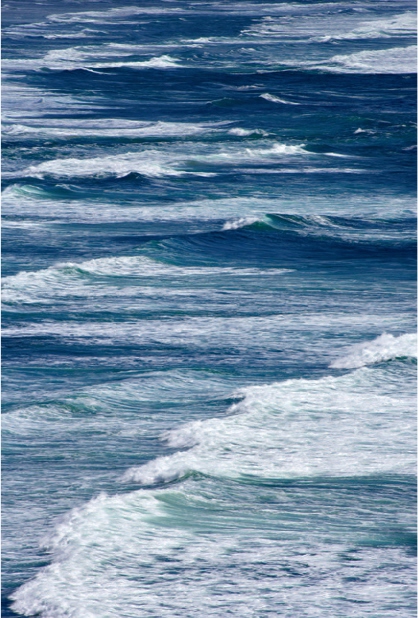
 WAVES
WAVES
Canon EOS 1Ds Mark II, 100-400mm zoom lens, 1/640th sec @ f16, digital ISO 400
Oregon, USA
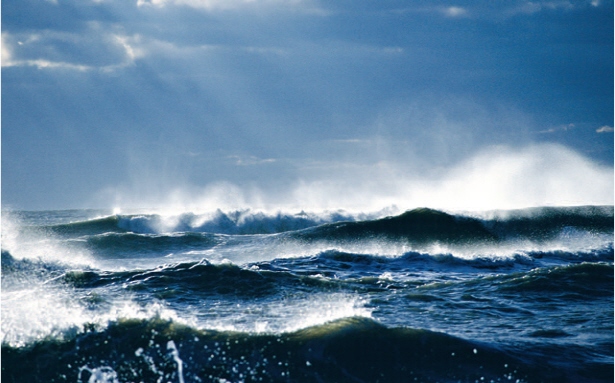
 COASTAL STORM
COASTAL STORM
Canon EOS 1V, 70-200mm lens, exposure unrecorded, Fuji Sensia film
Virginia, USA
FOCAL POINTS
The previous images worked because they created a mood or atmosphere, but they did not have a single strong point of interest. This is often difficult to achieve on a coast, because much of the environment is pretty featureless, especially when shooting towards the sea. Offshore stacks like the ones in this image are a real gift to a nature photographer, providing very strong anchor points when creating coastal landscapes. The shot is of Cannon Beach in Oregon, and was taken in the early evening when the sun was low in the sky. I had been hoping for a strong sunset, but due to the heavy cloud on the western horizon this was just not going to happen. At first glance the scene looked quite drab, but the clouds looked reasonably interesting, and I liked the reflections in the wet sand.
I played around with the scene with a 24-105mm lens, but this did not work because I could not capture enough of the sky. It was only when I switched to a wide-angle zoom, and looked through the viewfinder with the lens set to 17mm, that I found the shot I was after.

 OFFSHORE STACKS
OFFSHORE STACKS
Canon EOS 1Ds Mark II, 100-400mm zoom lens, 1/30th sec @ f11, digital ISO 100
Oregon, USA

 OFFSHORE STACKS
OFFSHORE STACKS
Canon EOS 1Ds Mark II, 17-40mm zoom lens @17mm, 1/8th sec @ f22, digital ISO 100
Oregon, USA
LEAD-IN
When photographing a relatively empty scene, it is useful to use something to draw the eye of the viewer towards one particular element that forms the focal point of the image. In the shot opposite the white foam ‘pointer’ does not actually go anywhere near the large offshore stack that is the focal point, but falls hundreds of metres short of it. A very wide-angle lens was used to emphasize the foreground, which appears to foreshorten the background, so in the picture the ‘lead-in’ or ‘pointer’ seems to go to almost the base of the rock. This is a deliberate optical illusion created by the appropriate lens choice for the desired effect.
Even though the early morning light was behind me, I was struggling to make an interesting image of the offshore stacks on Cannon Beach. The sky was not particularly inspiring, and the rock shapes looked less dramatic when lit from the front. As I wandered along the beach towards the rock, I came across a line of frothy bubbles that had been left in a place where a wave had retreated. I set up the tripod low to the ground, and positioned myself so that the meandering line led the eye to the giant haystack rock. Using a very wide-angle lens, the start of the line of bubbles was emphasized by being placed just a few centimetres from the lens. This wide-angle lens has a large depth of field, but because the foreground was so close I stopped down to f22 to ensure that everything in the frame was sharp. One of the great things about photographing landscapes is that, unlike wildlife, they do not move around very much. In most cases the shutter speed is irrelevant, so you can use low ISO speeds for maximum quality, and small apertures to create a maximum depth of field.
COASTAL FLOWERS
Coasts have their own special flora. One of my favourite seaside plants is Thrift, which produces masses of pale pink flowers in May and June around the British Isles, including Shetland, where the next two images were taken. The pictures were shot at the same place using the same lens, but they are very different.
Both of the images featured overleaf show the plant growing in its environment. It exists on virtually bare rock, so it is hard to see where it gets its nutrients, and because it grows so close to the sea it gets covered with salt water at regular intervals, particularly during winter storms. Being able to adapt to such a harsh environment has its advantages. Many plants cannot survive in such conditions so competition from other species is very low. Thrift is certainly a success story, and it is a very common plant found in many coastal locations.
While wandering around the coast of Mousa looking for images, I was attracted to a particular rock. Not only were there many Thrift plants on it in full bloom, but also due to the clean air of the Shetlands lichens thrived on it. The combination of the bright yellow lichen and pink flowers was irresistible. The dark sky in the background added drama to the scene, and contrasted nicely with the much paler rock in the foreground. The resulting image puts the prettiness of the flowers within the context of the constant struggle for life in the coastal environment.
The second image, taken not far away, shows a much closer view of a Thrift plant growing among the same yellow lichens. By concentrating on a single plant and framing the image to exclude much of the surrounding environment, a very different picture emerges. The details of the Thrift, lichens and texture of the rock dominate the frame. I used the strong sloping lines in the rocks to give the image structure, positioning the camera angle so that the lines started in the bottom left-hand corner. In this type of image, with no reference points to the horizon, you have considerable freedom to move your camera around for the angle that best suits the composition you have in mind.

 THRIFT-COVERED ROCK
THRIFT-COVERED ROCK
Canon EOS 1Ds Mark II, 28-135mm zoom lens @28mm, 1/160th sec @ f11, digital ISO 200
Shetland Isles, UK

 THRIFT (Armeria maritima) AND LICHEN
THRIFT (Armeria maritima) AND LICHEN
Canon EOS 1Ds Mark II, 28-135mm zoom lens @130mm, 1/250th sec @ f11, digital ISO 400
Shetland Isles, UK
BIRDS AND COASTS
A number of bird species are typical of coastal habitats. The most obvious of these are seabirds, although many only visit the coast to breed during the summer months. The waders, on the other hand, tend towards the reverse, with large flocks spending the winter on coastal mudflats, which they are dependent on for food. Of course, these are not the only bird species to be associated with coastal living, and many sea ducks and some geese are also reliant on this habitat for food and shelter during winter.

 MIXED WADERS AT HIGH TIDE
MIXED WADERS AT HIGH TIDE
Canon EOS 1D Mark II, 24-85mm zoom lens @56mm, 1/250th sec @ f16, digital ISO 400
Florida, USA
In my experience, the hardest pictures to take are those that show a bird actually with its coastal environment. It was easy to create the preceding images of Thrift using a wide-angle lens; plants, unlike birds, tend not to run away when you approach them. However, a location in Florida, where I found birds remarkably indifferent to human presence, provided an exception to this behaviour. I know of no other place on Earth where I could have taken the above picture of a group of mixed wading birds (or shorebirds as they are known in America).
The image was taken at Fort De Soto Park, on the Gulf coast of Florida near the city of St Petersburg. Being close to such a large city, the beach can be heaving with people, especially at weekends. Despite this, many waders winter here in large numbers – I guess they have become used to having people around. As the tide comes in and covers their feeding grounds, the waders gather together on the slightly higher ground, which remains dry or with only a shallow covering of water.
I noticed that a couple of people had walked quite close to a gathering of birds and had not disturbed them, so I thought I would try my luck. I decided against using a tripod because it might disturb the birds, and edged slowly forwards. None of the birds seemed worried by me, and I took several shots before retreating, still moving slowly so as to avoid disturbance. (Do not try this in Europe – if you do, you will send every bird within kilometres into a panic.)
The second image of a bird in its coastal environment, shown on these two pages, was taken at Olympic National Park using a more typical lens for wildlife photography – a long telephoto. The magnification factor of a telephoto lens is often essential for photographing birds because (apart from in Florida) they rarely allow a close approach.
The downside of using a long focal length is that the depth of field available is strictly limited, so getting both bird and background into focus is very difficult. In this image of a Brown Pelican diving into the sea between offshore stacks, the bird and the background are in focus, even though the picture was taken at f8, which is quite a wide aperture. This works because both the bird and the background are a long way from the camera. At a distance the available depth of field was at its greatest and encompassed both elements in the picture, even though the bird was much closer to the camera than the stacks. I would have liked to stop down to f16, but this would have resulted in a 1/100th second shutter speed, which would not have been enough to freeze the pelican.

 DIVING BROWN PELICAN (Pelecanus occidentalis) AND SEA STACKS
DIVING BROWN PELICAN (Pelecanus occidentalis) AND SEA STACKS
Canon EOS 1Ds Mark II, 100-400mm zoom lens @400mm, 1/400th sec @ f8, digital ISO 400
Washington State, USA
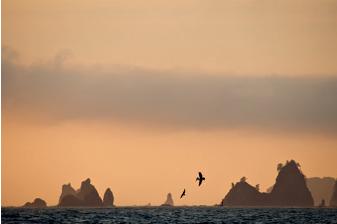
IMAGE AS RECORDED
BY THE CAMERA.
The final panoramic image was cropped from the original, which had far too much uninteresting sky in it. When taking the shot I wanted to frame the bird in between the two sets of stacks, so this determined the width of the composition. A few pelicans were present offshore and I had taken some pictures of them flying in between the stacks, but when this one prepared to dive I knew this was going to be the best shot of the session.
As I prepared to take the shot I was very much aware of a couple of seagulls that were hanging around hoping to benefit from any spare food should the pelican make a successful dive and come up with a fish. I did not want them in the picture, but could not do anything about it when the picture was taken. Later, while processing the image, I cloned out the gulls to create the image I had in my mind’s eye when I pressed the shutter. The original RAW file also looked rather dull (as RAW files tend to do), so I increased the colour temperature during conversion. Finally I had created the picture I wanted through a combination of digital capture and post processing of the digital image.
I have included a small picture that shows roughly what the RAW file looked like straight out of the camera. There are some who would disapprove of any digital manipulation of this sort, but I take the view that as the creator of the image I am free to realize my artistic vision by removing distracting elements that I have no control over during the digital capture. As for the change in colour temperature, I could easily have set this when I took the picture and nobody would have been any the wiser. I shoot in RAW, so am fully aware that the colour temperature can be adjusted after the event, which gives me much more control, and indeed artistic input, than settling on whatever the software in the camera comes up with. I am sure any artist using paints who witnessed the scene would not have included the distracting gulls in their painting. The beauty of digital is that photographers now enjoy similar freedom to control the final appearance of their own work. More artistic control is surely one of the big positives of the digital age.
INDIVIDUAL BIRDS
Apart from images that show birds in coastal habitats, coasts are great places for taking more typical bird pictures such as the shot opposite featuring a Sanderling running along the edge of the shore.
Sanderlings breed in the tundra of the far north, but spend their winters much further south. They are the archetypical shoreline waders, feeding right on the edge of the sea, where they run about like clockwork mice, up and down the beach following the waves as they break, then retreat back to the sea. I had always wanted to photograph one at full tilt, and on the tourist beach at Fort Myers early one morning I set up close to the shoreline and waited. There were several groups of these small waders scattered along the shore, but I saw little point in chasing them around. After a while one group approached from my left and I prepared myself for the shot. I kept as low as possible, both to create a good photographic angle and to keep a low profile so as not to scare the birds away. Some distance behind the birds, a jogger was running right along the shoreline. Once the birds became aware of him, rather than fly off they simply ran along the edge of the sea, just in front of me. I tracked one bird in the viewfinder and got the shot I was after. It was only later, when I examined the results closely, that I noticed that both the bird’s feet were completely off the ground.

 SANDERLING (Calidris alba)
SANDERLING (Calidris alba)
Canon EOS 1D Mark II, 500mm lens + 1.4x converter, 1/500th sec @ f8, digital ISO 400
Florida, USA
No mention of coastal birds would be complete without that most popular of seabirds, the Puffin. It is hard to take a bad picture of these cracking little birds, with their colourful bills and upright gait. Moreover, like many seabirds that spend most of their life at sea, they seem to be far less wary of humans than their landlubber cousins, which is great news for photographers.
When photographing seemingly ‘tame’ birds, it is nonetheless important to treat your subject with respect and move carefully and slowly when making an approach. In this way you avoid frightening the bird, which is good both for the bird and for you because it will not fly away. Once you have taken your prize-winning shot, do not be tempted to suddenly stand up and whoop in triumph. You should show just as much care in backing away from your subject as you did getting close to it. If it remains in the same place after you have backed away you have done a good job.
This particular Puffin photograph was taken on the sea cliffs on the island of Noss in the Shetlands. The footpath on Noss runs all around the coast of the island. I had taken my 400mm lens, which is half the weight of the 500mm lens, and I could hand-hold it. IS is very helpful when you are hand-holding long lenses, and because I used it in this instance I did not have to take my tripod on the long walk either, so saving even more weight.
I have to confess that I am not exactly sure what the Puffin is doing. I spotted the bird standing among some Thrift and it briefly put its head up and opened its mouth. I focused on the bird and waited. Sure enough it did it again and I got the shot. It looks as if it is calling, but no sound was produced.

 PUFFIN (Fratercula arctica)
PUFFIN (Fratercula arctica)
Canon EOS 1D Mark II, 400mm lens + 1.4x converter, 1/400th sec @ f8, digital ISO 400
Shetland Isles, UK
MAMMALS
Seals are probably the mammal I most associate with coasts, and although they can be quite nervous of people when they are on land, once in the sea they become far more confident and will often come over to investigate you.
This was certainly the case with the Common Seal shown below, photographed on the island of Yell in the Shetland Isles. At high tide these seals would often visit a small harbour close to where we were staying on the islands. My wife and I were sitting in the car alongside the harbour on a miserable grey-sky day with intermittent drizzle – a typical summer’s day on Shetland, in fact. We had seen four or five seals swimming around and frequently diving below the surface, but no photographic opportunities had presented themselves. Suddenly a seal surfaced nearby and I quickly took some pictures. The first couple of images were not much good, but the sound of the rapid-fire shutter had clearly been heard by the seal, because it stopped briefly and looked towards me. Those big doleful eyes looking slightly back towards the camera created a very satisfactory image of this lovely animal.
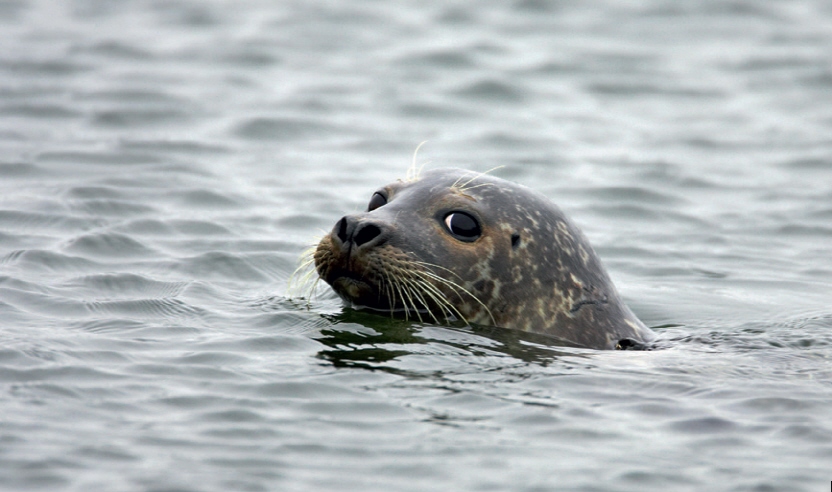
 COMMON SEAL (Phoca vitulina vitulina)
COMMON SEAL (Phoca vitulina vitulina)
Canon EOS 1D Mark II, 500mm lens + 1.4x converter, 1/650th sec @ f5.6, digital ISO 400
Shetland Isles, UK

 EUROPEAN OTTER (Lutra lutra)
EUROPEAN OTTER (Lutra lutra)
Canon EOS 1D Mark II, 400mm lens + 1.4x converter, 1/1,000th sec @ f5.6, digital ISO 400
Shetland Isles, UK
Another mammal that is found along coasts in the Shetland Isles is the European Otter, and although Shetland is its British stronghold it is still very difficult to see. My wife and I spent a month in Shetland and we only came across an otter on one occasion. I was photographing some birds when my wife spotted the otter swimming along the shoreline. We watched it from a distance, and saw it stop further along the shore among a large batch of seaweed. There was a gentle breeze, but it was blowing towards us so the otter could not detect our scent. I moved away from the immediate shoreline and set off slowly in the otter’s general direction. I used some very large boulders as cover as I approached it. By the time I was in position and close enough for a shot, the otter had curled up and gone to sleep. It did not make a very good subject because I could not even see its head. I waited around to see what would happen. A builder’s truck eventually came along the road that runs parallel to the shore, and the sound of it woke the otter. As it looked up I got just a few pictures before this engaging animal returned to the water and swam off, no doubt looking for a more peaceful spot for its afternoon nap.
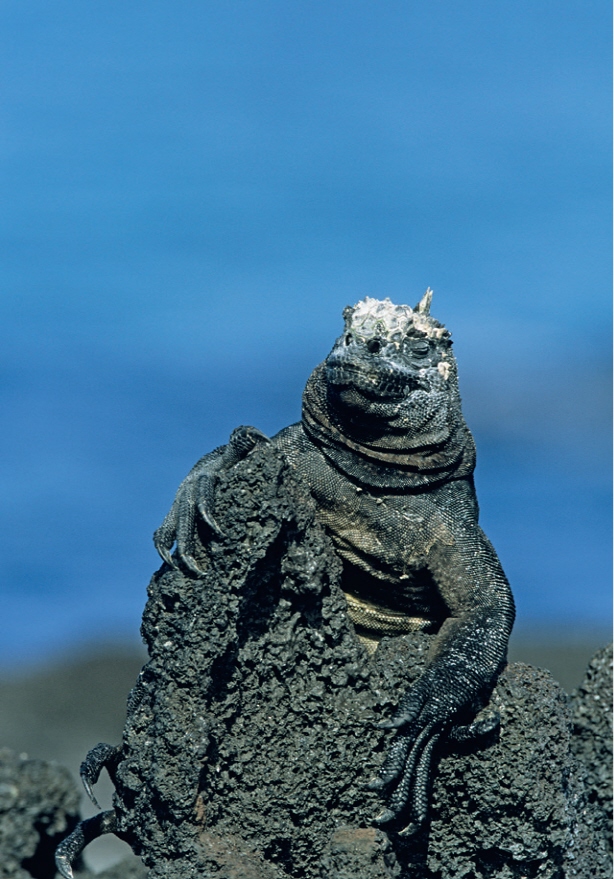
 MARINE IGUANA (Amblyrhynchus cristatus)
MARINE IGUANA (Amblyrhynchus cristatus)
Canon EOS 1V, 500mm lens, exposure unrecorded, Fuji Provia film
Galapagos Islands
REPTILES
The seashore is not a great place to find reptiles, but one very special species has made the coast its home – the Marine Iguana, which is only found on the Galapagos Islands. This spectacular lizard can grow to up to 1.7 metres long, and has evolved to such a size because it feeds on algae growing on the rocks under the surface of the sea. Despite being on the equator the waters around the Galapagos are very cold. The larger the lizard, the longer it can stay in the water to feed, because a larger body takes longer to cool down. Being cold blooded, if a lizard stayed in the water too long it would become torpid and drown.
The image of the Marine Iguana shown opposite was taken on the island of Fernandina, where much of the shore is covered in the random shapes produced by old lava flows from past volcanic eruptions. Most of the iguanas we saw were lying flat on the surface, and with their long and rather thin bodies did not lend themselves well to photography. Then I noticed this chap, walking slowly across the lava. When the lizard reached an upright piece of lava, it hauled itself up and settled down in the afternoon sun. With its claws wrapped around the black lava to hold itself in place, it made an interesting image. The background of similarly coloured lava distracted from the image, so I placed my camera bag on the lava and rested the long lens on it. I then lay rather uncomfortably flat on the rough ground and composed the shot, which at this low angle now had the blue sea as a background. It took a while to get everything set up in the right position, but fortunately the iguana was very happy in its new-found resting place and did not budge during the whole process.
WEIRD AND WONDERFUL TIDAL LIFE
Many interesting creatures that are specialists live in the littoral zone, the area of shoreline that is exposed at low tide. This is a strange environment that is revealed to us land-based observers twice a day before being covered again as the tide turns and the sea rushes in. Some of the most photogenic creatures found here must surely be the starfish, or sea stars as they are known in the USA. There are around 1,800 species worldwide, although by no means all of them live in the littoral zone. Those that do provide the land-based photographer with the opportunity to photograph these weird creatures without wearing a wetsuit.
I have included three images of starfish to give an idea of the variety of techniques that can be used to take interesting pictures. All were taken in Olympic National Park in Washington State, in the far north-western corner of the USA.

 SECOND BEACH WITH STARFISH
SECOND BEACH WITH STARFISH
Canon EOS 1Ds Mark II, 17-40mm zoom lens @21mm, 1/25th sec @ f20, digital ISO 100
Washington State, USA
The first picture returns to the theme of showing the subject in its environment, and was taken at the imaginatively named Second Beach. Low tide is essential for such pictures, because it is only then that the starfish can be seen. When we visited the area, low tide was in the early morning. This was good for photography, because apart from the nice light at this time of day, we were often alone. When I spotted a starfish clinging tightly to the exposed rock in an accessible position, I knew it would make a great foreground for the offshore stacks in the distance. It took a while to get my tripod set up in exactly the correct position. With the low sun behind me I had to ensure that shadows from both me and the camera gear did not fall across the foreground, especially since I was using such a wide-angle lens and was only centimetres away from the starfish.
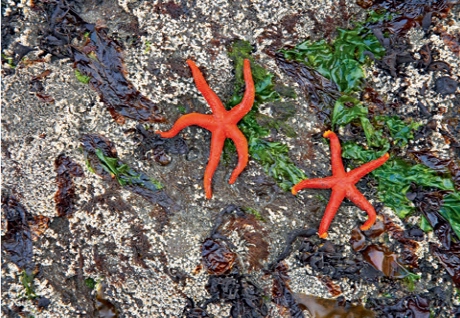
 BLOOD STARFISH (Henricia leviuscula)
BLOOD STARFISH (Henricia leviuscula)
Canon EOS 1Ds Mark II, 28-135mm zoom lens @135mm, 0.8th sec @ f22, digital ISO 200
Washington State, USA
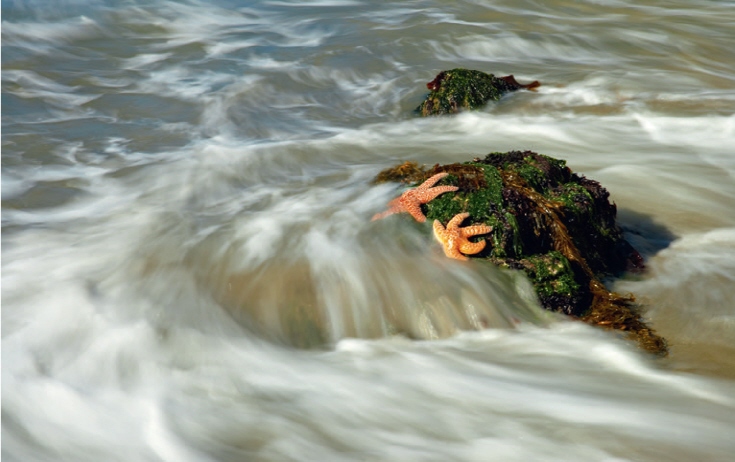
 OCHRE SEA STAR (Pisaster ochraceus) AND INCOMING TIDE
OCHRE SEA STAR (Pisaster ochraceus) AND INCOMING TIDE
Canon EOS 1Ds Mark II, 28-135mm zoom lens @95mm, 0.4th sec @ f36, digital ISO 50
Washington State, USA
The second image was taken on Third Beach. It is a simple portrait of two of the smallest starfish we found in the area, called the Blood Starfish for obvious reasons. I did not want a real close-up because the various textures on the rock they were clinging to would add to the picture. I therefore composed the image, putting them right of centre rather than slap-bang in the middle. The central starfish is very flat on the rock, but the other one is slightly curled up at the edges. Quite why this is I do not know – perhaps it was trying to move. I like the incredibly bright colour of the starfish in contrast with the muted browns and greens of the background.
The next starfish image, also taken on Third Beach, took several attempts. The littoral zone is all about the movement of the tide, and I wanted to record this. As the tide began to turn, I searched around for a suitable rock with starfish that would soon be reclaimed by the sea. Once I had found it, all I had to do was set up my camera on a tripod and wait for the incoming tide. In order to show movement I wanted the slowest shutter speed possible, so I stopped down as far as the lens would allow and set the ISO to ‘low’, which was 50 ISO. I then added a polarising filter to reduce the light entering the camera even further. This gave me a shutter speed of 0.4 seconds. I would have liked this to be longer, but in sunny conditions this was the best I could manage. Camera manufacturers spend a lot of time and money giving us ever-higher ISO values on their cameras, but sometimes it would be very useful to set the ISO at 10 ISO or even less. I suppose I really should get around to buying a set of neutral-density filters one day.
The problem with such slow shutter speeds is camera movement, but if the camera is set up on a sturdy tripod this should not be a problem. My tripod was set up on soft sand, however; as the tide came in and I took the shot, the incoming seawater shifted the sand under the tripod’s feet and it began to slowly sink during the long exposure. I tried several times with the same result. Eventually I fetched a few stones from further up the beach, put them under the tripod’s feet and rammed the tripod down into the sand as much as possible. This worked and I finally got the shot I was after, which shows the two starfish clinging to the rock as the tide sweeps over them.
For my final picture I have chosen a representative of one of the most familiar coastal animals, the crabs. This is not one of the rather drab-coloured crabs of my British seaside childhood, but the fantastically colourful and wonderfully named Sally Lightfoot Crab, photographed in the Galapagos Islands.
I encountered these crabs, which are common on the Galapagos Islands but not restricted to them, on several of the islands, but found them difficult to photograph. Whenever I approached them, they would skulk away and hide among the rocks. On the island of Fernandina, however, the crabs seemed much bolder and would scuttle around over the black lava shoreline scavenging for food. The lava made a dramatic background to my chosen crab, but being so dark needed to be taken into consideration when determining the exposure. If used on automatic, the camera would have got it wrong and overexposed the crab. The picture needed to be underexposed by a stop compared with the camera’s meter reading.
As the crab moved sideways over the lava it would raise itself up on its legs, and that was the shot I was after. I was working with a hand-held long lens and needed to maximize the shutter speed, so I was shooting wide open, giving me very little depth of field. I sat down and rested the lens on my knee so that I had some stability and was at a low angle. To ensure all of the crab was sharp, I positioned myself directly in front of it so that it was parallel to the back of the camera. This made the most of the limited depth of field available to me.
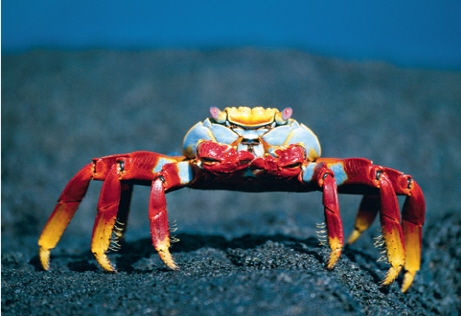
 SALLY LIGHTFOOT CRAB (Grapsus grapsus)
SALLY LIGHTFOOT CRAB (Grapsus grapsus)
Canon EOS 1V, 100-400mm lens, exposure unrecorded, Fuji Provia film
Galapagos Islands